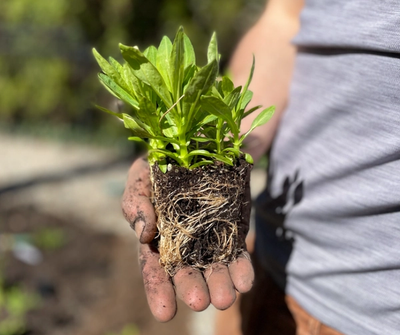Why Fall is the Best Season to Plant Native Plants


Learn why fall offers some of the best planting conditions to set your native garden up for success.
https://www.myhomepark.com/collectionsFall is just around the corner, and you may be wondering if it’s too late to plant your garden. The good news is, it’s not too late at all! In fact, fall is one of the best seasons for planting native perennials. Here is why this season offers some of the best planting conditions:
Watch David Levine, Co-founder and CEO describe why fall is the best time to plant native perennials.
Ideal Soil Conditions
While the heat of summer is subsiding, the soil in your garden bed still retains some warmth well into early fall. The warm soil retains moisture, and encourages plants to invest their energy and resources towards growing a strong root system. This optimal soil environment reduces shock and minimizes stress when transplanting young plants giving them a strong start. Healthy root growth is key for the long term success of any perennial, so planting in the fall can set the stage for a thriving garden come spring.
Cooler Air Temperature
While the soil may still be warm from summer, the air is beginning to cool down. This signals to plants they need to invest energy in their root systems to prepare for winter. Additionally, the cooler air temperature provides a more comfortable environment for planting and gardening activities.
Reduced Maintenance
The colder temperatures also mean there are fewer pests and weeds to cause concern and require maintenance. The minimal presence of weeds means there is less competition in resources for the plants, giving them better access to the necessary water and nutrients they need. The higher rainfall during this season reduces your need for supplemental watering, saving you both time and money.
Early Support for Next Year’s Pollinators
Planting in the fall greatly benefits future pollinator populations. The ideal planting conditions provided by this season put new plants on a fast track for success. When spring rolls around, overwintered plants will be on their natural clocks, generally blooming earlier than spring-planted perennials, and offering food for butterflies, bees, and other beneficial wildlife.

New England Asters (Symphyotrichum novae-angliae) burst into full bloom in mid-September.
Timeline for Planting
The optimal time for fall planting varies by region due to differences in climate and frost dates. Generally, the plants should be in the ground before the first frost. Here are some guidelines for planting by region:
Northeastern US (Maine, New Hampshire, Vermont, Massachusetts, Rhode Island, Connecticut, New York, New Jersey, Pennsylvania, Maryland): Late August - Mid October
Midwestern US (Ohio, Indiana, Illinois, Michigan, Wisconsin, Minnesota, Iowa, Missouri, North Dakota, South Dakota, Nebraska, Kansas): Late August - Early October
Southeastern US (Virginia, North Carolina, South Carolina, Georgia, Florida, Alabama, Mississippi, Tennessee, Kentucky, Louisiana, Arkansas): Late October - Late November
Pacific Northwest US (Washington, Oregon, Northern California): September - November
Southwestern US (Arizona, New Mexico, Southern Nevada, Southern Utah, Western Texas): October - November
California (Coastal California, Inland California, Southern California): September - November
We highly recommend starting your garden in the fall! By planting in harmony with your plants' natural growing patterns and environment, you'll set them up for success. You'll also avoid contending with the intense heat, pests, and weeds that are more prevalent in other seasons. Plus, you'll save time and money with less maintenance and watering. Check out our garden collections tailored to your region and start your fall garden today!

Share this article


